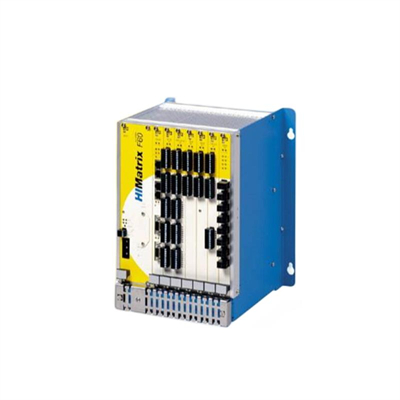ABB SPCJ4D34-AA electric protection relay
3. Easy to install and maintain
The compact design and standard installation interface make the installation process of relays simple and fast, and can be easily integrated into various power equipment and systems. At the same time, the friendly human-computer interaction interface and remote communication function make it easy for operation and maintenance personnel to set parameters, troubleshoot, and perform daily maintenance, reducing maintenance costs and difficulties, and improving equipment availability.
4. Flexible scalability
Supporting multiple communication protocols and interfaces, it can be easily integrated and networked with other power protection devices and monitoring systems to achieve intelligent protection and management of the power system. Its flexible parameter setting function can also meet the personalized protection needs of different scales and types of power systems, with good scalability and adaptability.
Precautions
1. Installation requirements
The installation environment should be dry, well ventilated, and away from high temperature, humidity, dust, and corrosive gas environments to avoid environmental factors affecting the performance and service life of the relay.
Ensure that the installation location has sufficient space for heat dissipation and daily maintenance operations. During installation, electrical connections should be strictly made according to the requirements of the product manual to ensure secure and correct wiring, and to avoid relay malfunction or safety accidents caused by wiring errors.
2. Parameter settings
When setting parameters, it is necessary to fully understand the actual operation and protection requirements of the power system, and strictly follow the prescribed operating procedures. After the setup is completed, necessary testing and verification should be conducted to ensure the accuracy and reliability of the protective actions. To avoid relay misoperation or inability to respond to faults in a timely manner due to improper parameter settings.
3. Operation monitoring
During the operation of the relay, it is necessary to regularly monitor its operating status, check whether the indicator lights display normally, whether communication is smooth, and whether various parameters are within the normal range. If any abnormal situation is found, timely troubleshooting and handling should be carried out, and professional technicians should be contacted for maintenance if necessary.
4. Maintenance and upkeep
Regularly clean the relay, remove dust and dirt from the surface, and maintain good heat dissipation performance. Perform performance testing and calibration on the relay according to the prescribed cycle, promptly replace aging or damaged components, and ensure that the relay is always in the best working condition.
Similar model supplement
1. ABB SPCJ4D34-BB
Compared with SPCJ4D34-AA, SPCJ4D34-BB has differences in the rated voltage range, with a rated voltage of AC 220V -380V, making it more suitable for industrial power systems with higher voltage levels. In terms of protection function types, SPCJ4D34-BB has added negative sequence current protection function, which can better cope with faults such as three-phase imbalance and provide more comprehensive protection for the power system.
2. ABB SPCJ4D34-CC
This model has been upgraded in terms of communication function, in addition to having RS485 interface and Modbus protocol, it also adds Ethernet interface and supports TCP/IP protocol, which can achieve faster and more stable data transmission and remote monitoring. At the same time, the protection level of SPCJ4D34-CC has been upgraded to IP30, with better dust and foreign object intrusion resistance, suitable for industrial environments with harsh conditions. Users can choose the appropriate model based on their actual power system needs, budget, and requirements for functionality and protection level.

- EMERSON
- Honeywell
- CTI
- Rolls-Royce
- General Electric
- Woodward
- Yaskawa
- xYCOM
- Motorola
- Siemens
- Rockwell
- ABB
- B&R
- HIMA
- Construction site
- electricity
- Automobile market
- PLC
- DCS
- Motor drivers
- VSD
- Implications
- cement
- CO2
- CEM
- methane
- Artificial intelligence
- Titanic
- Solar energy
- Hydrogen fuel cell
- Hydrogen and fuel cells
- Hydrogen and oxygen fuel cells
- tyre
- Chemical fiber
- dynamo
- corpuscle
- Bently
- Pulp and paper
- printing
- fossil
- FANUC
- Food and beverage
- Life science
- Sewage treatment
- Personal care
- electricity
- boats
- infrastructure
- Automobile industry
- metallurgy
- Nuclear power generation
- Geothermal power generation
- Water and wastewater
- Infrastructure construction
- Mine hazard
- steel
- papermaking
- Natural gas industry
- Infrastructure construction
- Power and energy
- Rubber and plastic
- Renewable energy
- pharmacy
- mining
- Plastic industry
- Schneider
- Kongsberg
- NI
- Wind energy
- International petroleum
- International new energy network
- gas
- WATLOW
- ProSoft
- SEW
- wind
- ADVANCED
- Reliance
- YOKOGAWA
- TRICONEX
- FOXBORO
- METSO
- MAN
- Advantest
- ADVANCED
- ALSTOM
- Control Wave
- AB


email:1583694102@qq.com
wang@kongjiangauto.com












































































































